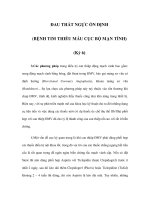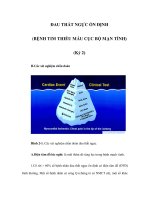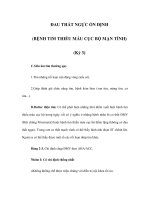Các tranh luận trong điều trị cơn đau thắt ngực ổn định
Bạn đang xem bản rút gọn của tài liệu. Xem và tải ngay bản đầy đủ của tài liệu tại đây (3.17 MB, 37 trang )
Chronic Stable Angina:
Evidence-Based Guide to
Revascularization
Khôi M. Lê, MD
Desert Cardiology Center
Eisenhower Medical Center
Rancho Mirage, California
USA
Why do we treat?
To help the person live longer (reducing mortality)
To help the person live better (reducing symptoms)
Standard treatment options for
angina
Lifestyle modifications Medications
Angioplasty/stenting Bypass surgery
Outline
Review selected landmark clinical trials
FAME
COURAGE
BARI 2D
MASS II
SYNTAX
Provide a framework for decision-making
Guidelines
Appropriateness criteria
FAME
Tonino PA et al. N Engl J Med 2009;360:213-224.
Fractional flow reserve (FFR)
measurements vs angiography
to guide PCI decision-making
Findings from FAME
Tonino PA et al. N Engl J Med 2009;360:213-224.
Fractional flow reserve
measurements are
superior to angiography
in guiding decision-
making regarding
revascularization
Treatment of
nonischemic lesions led
to worse clinical
outcomes
Kaplan-Meier Survival Curves
Boden WE et al. N Engl J Med 2007;356:1503-1516
COURAGE: No difference in
long-term survival, ACS, MI
COURAGE: Angina-free (%)
P= NS
P<0.001 P=0.02
P=NS
Angina relief is higher
in the PCI group at 1
and 2 years, but there is
also substantial
improvement with
medical-therapy
At 5 years angina relief
is equivalent
Weintraub WS et al. N Engl J Med 2008;359:677-687
COURAGE:
Effect of PCI on
Quality of Life in
Patients with Stable
Coronary Disease
* Indicates P<0.01 for
difference between treatment
groups
COURAGE: Need for
Subsequent Revascularization
At a median 4.6 year follow-up, 21.1% of the PCI patients required an
additional revascularization, compared to 32.6% of the OMT group
who required a 1
st
revascularization
77 patients in the PCI group and 81 patients in the OMT group
required subsequent CABG surgery
Median time to subsequent revascularization was 10.0 mo in the PCI
group and 10.8 mo in the OMT group
Mortality in Randomized Trials Comparing
the PCI With Medical Treatment
Meta-analysis of 7513
patients in 17
randomized trials
PCI was associated
with a 20% reduction in
death
COURAGE may have
been underpowered to
detect a mortality
benefit
20%
reduction
JACC 2008;52:894-904
Lifestyle Pharmacologic
COURAGE:
Optimal Medical Therapy
Smoking cessation
Exercise program
Nutrition counseling
Weight control
Anti-platelet
Statin ± ezetimibe or ER
niacin
Beta-blocker
Calcium channel blocker
Long-acting nitrate
ACE Inhibitor or ARB
COURAGE: Risk factor goals
Variable Goal
Smoking Cessation
Total Dietary Fat / Saturated Fat <30% calories / <7% calories
Dietary Cholesterol <200 mg/day
LDL cholesterol (primary goal) 60-85 mg/dL
HDL cholesterol (secondary goal) >40 mg/dL
Triglyceride (secondary goal) <150 mg/dL
Physical Activity 30-45 min. moderate intensity 5X/week
Body Weight by Body Mass index Initial BMI
Weight Loss Goal
25-27.5 BMI <25
>27.5 10% relative weight loss
Blood Pressure <130/85 mmHg
Diabetes HbAlc <7.0%
COURAGE:
Optimal medical
therapy
Percent of Patients Taking
Medications During the
Trial
Maron, D. J. et al. J Am Coll
Cardiol 2010;55:1348-1358
The COURAGE trial:
Take home messages
For every 1000 patients treated with a PCI-first strategy,
compared to optimal medical therapy
≈ 800+ will have the same outcome as those treated medically
+ 60-90 will have symptomatic benefit for 6-24 months
− 28 will have a periprocedural myocardial infarction
− 2 will die
Consider treating patients with stable symptoms with medical
therapy first and reserving PCI for continued symptoms
Additional insights from
COURAGE
Identification of patients that will likely respond inadequately
to optimal medical therapy
Identification of patients at high-risk for future clinical events:
Can revascularization be protective?
COURAGE:
Benefit of PCI is related to
baseline frequency of angina
Multiple episodes per week
About 1 episode per week
Episodes only rarely
Years from Baseline
Seattle Angina Scores (higher scores = less angina)
Weintraub WS et al. N Engl J Med 2008;359:677-687
COURAGE: Baseline and
posttreatment gated MPS results
P=0.63 P<0.0001
P=0.06
P=0.02
P=0.0004
Shaw L J et al. Circulation 2008;117:1283-1291
Shaw L J et al. Circulation 2008;117:1283-1291
Kaplan–Meier survival for
patients by residual ischemia,
after 6 to 18 months of
PCI+OMT or OMT.
Extent of residual ischemia is predictive of cardiac
events (death/MI)
COURAGE
Modification of message?
Although patients with ischemic heart disease and stable
symptoms should be offered optimal medical therapy initially,
those with severe symptoms and/or a significant burden of
ischemia may benefit from early rather than deferred
revascularization
BARI 2D: Trial design and enrollment
The BARI 2D Study Group. N Engl J Med 2009;360:2503-
2515
BARI 2D: Rates of Survival and Freedom from Major
Cardiovascular Events, According to PCI and CABG Strata
NEJM 2009;360:2503-2515
• There was no survival
benefit to early
revascularization over
medical therapy
• The subset of patients
with a greater extent of
CAD (selected for the
CABG vs medical
therapy stratum) may
benefit from earlier
revascularization
• Overall, the findings
confirm the results of
the COURAGE trial
Patient Selection Treatment and Follow-up
MASS II: Study Design
Multivessel proximal
coronary stenoses >70%
Ischemia
Stress testing
CCS class II or III
Appropriate for PCI or
CABG
Randomized
Optimal medical therapy
PCI
CABG
Primary endpoint composite
of death, MI, angina
requiring revascularization
Follow-up every 6 months
for 10 years
MASS II: Major Adverse Cardiac
Events at 10-year Follow-up
Hueb W et al. Circulation 2010;122:949-957
Conclusions from MASS II
In patients with stable angina and multivessel disease,
revascularization, especially bypass surgery, reduces cardiac
death and MI.
COURAGE and MASS II results, although apparently
contradictory, can be reconciled by considering the extent of
disease
Single vessel disease (31% in COURAGE, 0% in MASS II)
Proximal LAD disease (34% in COURAGE, 92% in MASS II)
CCS Class 0 or I (42% in COURAGE, 0% in MASS II)









